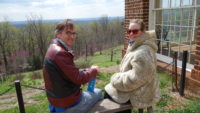 This blog entry is brought to you by Kelly Horwitz, my sister, who recommended most of today’s itinerary!
This blog entry is brought to you by Kelly Horwitz, my sister, who recommended most of today’s itinerary!
From our cabin, Charlottesville is about a two-hour drive away, so I was a little hesitant to go all that way. So, I e-mailed my sister, who lived there for three years while getting her law degree. I was pretty sure she was going to volunteer to come and guide us around, her praise of the place was so high. I also came to the conclusion that I have driven almost two hours to go to parts of Amish country back in Ohio, so that settled it – westward we went.
It had rained all night long, but had stopped by the time we got to our destination. But it had gotten cold – 40s with wind, which was a far cry from the sunny and 70s we had been enjoying. So we had a rare day on which my often-commented-on Spider-Man jacket was on display next to Meredith’s “whoa!” fuzzy winter jacket. One lady at lunch said she loved both our jackets. We were pleased with that.
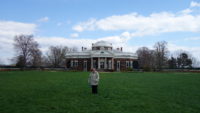 Our first stop of the day was a little country shack called Monticello, the home of Thomas Jefferson. We got to see a ten-minute film on Jefferson that focused largely on the contradictions of a man who fought hard for liberty, but kept slaves. I would have liked more of Jefferson’s own words in the film, but it was okay. We actually got to see it twice, because we waited for Jefferson himself to show up in the form of (wait for it) Williamsburg’s actor. When you don’t go to Williamsburg, Williamsburg comes to you. I thought George Wythe was a more powerful speaker, but Jefferson presented his ideas in a conversational tone that was pleasing. He spoke about the delicate nature of a democracy, and how we needed to be vigilant in preserving our liberties by remembering the words of the Declaration of Independence. He spoke for twenty or twenty-five minutes, and then we were ready to head up to the house.
Our first stop of the day was a little country shack called Monticello, the home of Thomas Jefferson. We got to see a ten-minute film on Jefferson that focused largely on the contradictions of a man who fought hard for liberty, but kept slaves. I would have liked more of Jefferson’s own words in the film, but it was okay. We actually got to see it twice, because we waited for Jefferson himself to show up in the form of (wait for it) Williamsburg’s actor. When you don’t go to Williamsburg, Williamsburg comes to you. I thought George Wythe was a more powerful speaker, but Jefferson presented his ideas in a conversational tone that was pleasing. He spoke about the delicate nature of a democracy, and how we needed to be vigilant in preserving our liberties by remembering the words of the Declaration of Independence. He spoke for twenty or twenty-five minutes, and then we were ready to head up to the house.
We walked up to enjoy the unfolding views. Monticello is on a small mountain, and so the scenery changes all the time. The walk also led us past the large, still-used family cemetery where Jefferson is buried, with a grave marked by a ten-foot obelisk.
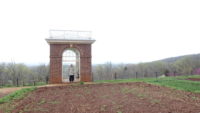 We approached the house from an angle, and lower down, along the gardens on the north side of the hill. So I decided to explore all around the house and save the front for last. We couldn’t go in the house because those tickets had sold out online, but we were fine wandering the grounds. The keepers of Monticello are trying to recreate the gardens as Jefferson had them, and I’m not sure where they are in the process. There were full beds of plants growing, and it was a very pretty spot, so much so that Jefferson had a small writing space constructed there. He would work in the garden some, and then write in his little office overlooking the valley and mountains.
We approached the house from an angle, and lower down, along the gardens on the north side of the hill. So I decided to explore all around the house and save the front for last. We couldn’t go in the house because those tickets had sold out online, but we were fine wandering the grounds. The keepers of Monticello are trying to recreate the gardens as Jefferson had them, and I’m not sure where they are in the process. There were full beds of plants growing, and it was a very pretty spot, so much so that Jefferson had a small writing space constructed there. He would work in the garden some, and then write in his little office overlooking the valley and mountains.
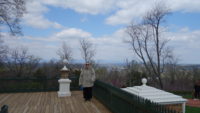 The estate originally had a line of buildings along “Mulberry Row,” which housed free workers and slaves, and housed small shops where things the estate needed were made, or were sold. Most of those buildings are gone, but some have been reconstructed, and Jefferson’s stable still exists. All of the buildings that had information available talked about the enslaved people who lived and worked there, and a few mentioned the free workers who helped to build the house itself.
The estate originally had a line of buildings along “Mulberry Row,” which housed free workers and slaves, and housed small shops where things the estate needed were made, or were sold. Most of those buildings are gone, but some have been reconstructed, and Jefferson’s stable still exists. All of the buildings that had information available talked about the enslaved people who lived and worked there, and a few mentioned the free workers who helped to build the house itself.
We wandered up to the back of the house, which is not unusually impressive compared to the more famous front, but has the advantage of far better views. We made our way into a tunnel that went through the basement and storerooms, learning how the household ran.
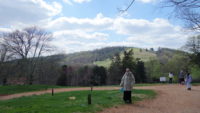 We finally came around to the front of the house, which is beautiful. To our surprise, it is not huge. It is large, of course, but with much of the space out of sight in the basements and under the two wings of the house, it looked to be a magnificent large home, and not the palace-sized building I had always supposed it would be.
We finally came around to the front of the house, which is beautiful. To our surprise, it is not huge. It is large, of course, but with much of the space out of sight in the basements and under the two wings of the house, it looked to be a magnificent large home, and not the palace-sized building I had always supposed it would be.
We stopped by a few places we had missed, including the rest of Mulberry Row, and headed back down the path to the parking area. We had a short drive to our lunch place, the Michie Tavern, which dates from about 1793. Kelly had recommended it. In her words – “On the way to TJ’s is Michie Tavern which dates to the 1700s. (Although I think they moved the tavern to its current location from elsewhere, so I don’t think TJ and Monroe were pounding brews there.)” Even if Jefferson never tipped back a brewski there, we got to have our first buffet in a year – really excellent southern food. The concession for the pandemic was we had to wear our masks and put on plastic gloves before we could get to the serving area. We may have had two plates, and the ambiance was great – bare wood everywhere, and tin plates and cups. I loved it.
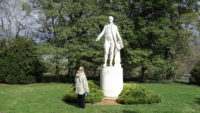 Stop three on the Tour de Charlottesville was Highland, the estate of James Monroe. The setting of Highland was also quite pretty, but may have been better in that it was lower than the surrounding hills on a couple of sides, so the hills were close up, instead of across a valley. The down side is that the actual house Monroe built and lived in for a time burned to the ground (probably between 1730 and 1750, after he had sold the plantation), and then was completely lost to memory. It was found again in 2014 after some small archeological work was done on site, and they hope to do more this summer.
Stop three on the Tour de Charlottesville was Highland, the estate of James Monroe. The setting of Highland was also quite pretty, but may have been better in that it was lower than the surrounding hills on a couple of sides, so the hills were close up, instead of across a valley. The down side is that the actual house Monroe built and lived in for a time burned to the ground (probably between 1730 and 1750, after he had sold the plantation), and then was completely lost to memory. It was found again in 2014 after some small archeological work was done on site, and they hope to do more this summer.
It turns out what had always been presented as Monroe’s house was actually a guest house (from 1818) and a later addition from 1870. Ooops. They confirmed the dates by dating the tree rings in the timbers used in the existing house. A few outbuildings still survive as well.
 Kelly had mentioned she liked the peacocks wandering about, but sadly, they are no more. There are sheep and a donkey and a kitty on the property, but we didn’t get a chance to see the kitty. We did have a long talk with a docent, and she filled us in on all the complexities of working out what had happened to the estate, and how that knowledge keeps changing. We also talked some about Monroe’s slaves, and how he sold many of them off to take care of his debts, but that he refused to break up family groups, even if it meant less money for him.
Kelly had mentioned she liked the peacocks wandering about, but sadly, they are no more. There are sheep and a donkey and a kitty on the property, but we didn’t get a chance to see the kitty. We did have a long talk with a docent, and she filled us in on all the complexities of working out what had happened to the estate, and how that knowledge keeps changing. We also talked some about Monroe’s slaves, and how he sold many of them off to take care of his debts, but that he refused to break up family groups, even if it meant less money for him.
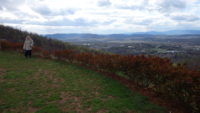 The final destination of the day was the University of Virginia, but I took a whimsical detour up to Carter Mountain Orchard. The views from on top of the mountain were breathtaking, but some of that may have been the thirty-mph winds whipping around up there. I hope to go back some day when we can sit and enjoy it.
The final destination of the day was the University of Virginia, but I took a whimsical detour up to Carter Mountain Orchard. The views from on top of the mountain were breathtaking, but some of that may have been the thirty-mph winds whipping around up there. I hope to go back some day when we can sit and enjoy it.
UVA was where Meredith’s dad got his ABD (all but dissertation) degree in English, and my sister got her law degree. Also, it was where Edgar Allan Poe went to school for one semester before having to withdraw because of lack of money. That doesn’t stop UVA from having a marker on Poe’s room and having it viewable from outside, as well as having a medallion in the street leading up to his dorm. We were actually glad they honored him that way, and Meredith was able to get pictures of the Poe-related things.
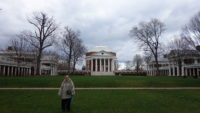 We stopped by The Lawn, which is the heart of the original campus that Jefferson designed during his retirement. It is harmonious and symmetrical, and I found it to be very pleasing. Not bad for a self-trained amateur architect.
We stopped by The Lawn, which is the heart of the original campus that Jefferson designed during his retirement. It is harmonious and symmetrical, and I found it to be very pleasing. Not bad for a self-trained amateur architect.
Hey, where’s the rest of the post??
YOU DIDN’T GET TO GO IN THE HOUSE?! Now you’ll need to go back.
With Covid, my guess is most of the rooms were probably closed anyway. What I want it to go on the upstairs (including dome) tour, but that is $350 for the group. Want in on that? 🙂
Your papa-in-law would be pleased that you’re tromping around his stomping grounds. I’d say it was well worth the drive. Are you staying in Williamsburg and day-tripping all week?
Yep. We like having a place to dump the stuff and go. 🙂